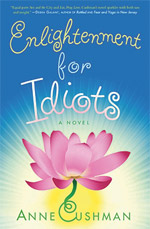
An unplanned pregnancy, a rocky romance, an unsatisfying job, and a milestone birthday: Amanda, the intrepid twenty-nine-year-old heroine of Enlightenment for Idiots (Random House, 2008, $24.00 cloth, 384 pp.), has got a lot on her plate even before a spiritual pilgrimage gets thrown into the mix. When Amanda receives an assignment to write a travel guide for aspiring awakened ones, she finds herself in India, looking for love—and gurus—in all the wrong places. Written by Tricycle contributing editor and yoga teacher Anne Cushman, Enlightenment for Idiots traces, with witty flair, Amanda’s encounters with heartbreak, culture shock, yoga, and a kooky traveling companion named Devi Das. The novel’s warmhearted spirit is captured in the advice Amanda receives from a friendly waiter: “What happens to us in life is for God to decide. Whether to be happy or not—that is our choice.”
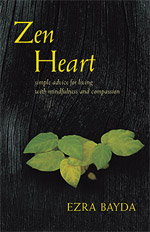
On her search for truth and happiness, Amanda might have benefited from Zen teacher Ezra Bayda’s new guide to spiritual practice, ZEN HEART: SIMPLE ADVICE FOR LIVING WITH MINDFULNESS AND COMPASSION (Shambhala Publications, 2008, $21.95 cloth, 208 pp.). Bayda recommends dividing the practice of Zen into three stages: the “Me-Phase,” in which we learn to recognize our deeply-rooted behaviors and beliefs; “Being Awareness,” in which the emphasis moves away from the self toward practicing mindfulness, and finally “Being Kindness,” in which the practitioner learns to cultivate and connect with “the lovingkindness and compassion that are our true nature.” Zen Heart also includes several practices for daily life: mapping the mind, gatha walking meditation (in which the practitioner repeats a verse silently as he or she walks), and nightly reflection. The book is marked by Bayda’s optimism: Rather than become discouraged and guilt-ridden when we fall below our own expectations, we are encouraged to strive for “self-knowledge without self-judgment.”
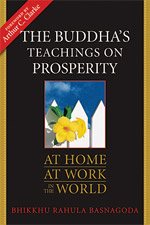
The Buddha-curious everyman might also find inspiration in THE BUDDHA’S TEACHINGS ON PROSPERITY: AT HOME, AT WORK, IN THE WORLD (Wisdom Publications, 2008, $16.95 paper, 200 pp.). Bhikkhu Basnagoda Rahula, a Sri Lankan monk (and English Lit Ph.D.) who teaches at the Houston Buddhist Vihara, aims to make Buddhist teachings applicable to worldly matters, from financial debt to proper parenting. Occasionally, the author’s interpretations can seem dated, particularly when the book addresses gender roles (“While he might not mind driving a decade-old, rusty truck, she would prefer a beautiful new car,” Bhikkhu Rahula writes). Still, there’s some good advice in this straightforward book, and its organized structure (lots of numbered lists, steps, and summaries) makes it a handy resource for secular readers who like their Buddhism strained of abstractions.
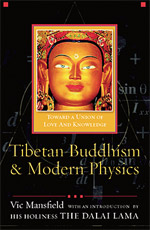
Abstractions are the order of the day in Vic Mansfield’s TIBETAN BUDDHISM AND MODERN PHYSICS (Templeton Foundation Press, 2008, $19.95 paper, 192 pp.), which takes up the Dalai Lama’s call for collaboration between science and Buddhism. (The book’s contributors represent the promise of such a partnership: Mansfield is a professor of physics and astronomy at Colgate University, while the Dalai Lama himself penned the foreword.) There’s something in this book for everyone: physics buffs can revel in Mansfield’s discussion of photons, Einstein, and quantum nonlocality, while non–rocket scientists will likely be fascinated by his insightful commentary on the relationship between the Buddhist principle of emptiness and special relativity—and how a better understanding of modern physics could help bring about a lasting peace. Though Mansfield dapples his book with intimidatingly titled diagrams like “The Galaxy cluster as gravitational lens,” his ample use of anecdotes and personal commentary make even quantum physics seem simple enough—relatively speaking.
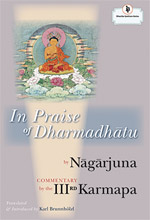
How does Buddha-nature reveal itself over time? A new translation of Nagarjuna breaks down his classic hymn to the process by which Buddha-nature can surface. Translator Karl Brunnhölzl’s IN PRAISE OF DHARMADHATU (Snow Lion Publications, 2008, $29.95 cloth, 304 pp.) takes on both the teachings of Nagarjuna, the founder of the Madhyamaka (Middle Path) school of Mahayana Buddhism, and commentary by the 13th-century Tibetan master Rangjung Dorje, the Third Karmapa. Brunnhölzl hasn’t exactly written a beach book. However, his thorough, comprehensive approach to his subject makes the book a useful reference for students. And the three-stage process of Buddha-hood outlined by Nagarjuna—in which one’s innate Buddha-nature, first buried, emerges as one follows the path of bodhisattvas and eventually flourishes—becomes more accessible through Brunnhölzl’s clear prose.
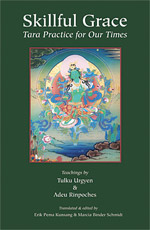
The Tibetan bodhisattva Tara, revered for her compassion and wisdom, is the Angelina Jolie of Buddhism—peaceful warrior, mother-protector, and noted beauty all in one. As with any much-admired public figure, there are many who would like to follow in her footsteps. Thanks to SKILLFUL GRACE: TARA PRACTICE FOR OUR TIMES (North Atlantic Books, 2007, $15.95 paper, 184 pp.), by the late Kagyu masters Tulku Urgyen Rinpoche and Trulshik Adeu Rinpoche, eager readers now have a lucid, elegant introduction to Tara practice and Vajrayana Buddhism at their fingertips. Tulku Urgyen and Trulshik Rinpoche ground the book in The Essential Instruction on the Threefold Excellence,the root treasure text by Chogyur Lingpa, which aims to meld all Buddhist schools into “a single path that one person can follow.” With guided meditations, yoga postures, and visualizations, the emphasis here is on action, and the authors take care to acknowledge the challenges of practice. “Until true devotion arises genuinely,” they write of one practice, “you need to create a facsimile of devotion at the beginning of each session.” In other words, fake it till you make it.
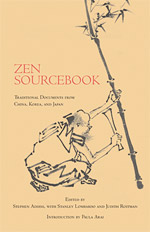
“There is another place/for conversing/heart to heart,” Zen master Muso Soseki wrote almost seven centuries ago. “The full moon/and the breeze/at the half-open window.” The timeless words of Zen masters running the gamut from the well-known (Dogen and Bodhidharma) to the more obscure (miscellaneous Chinese nuns) can be found in ZEN SOURCEBOOK: TRADITIONAL DOCUMENTS FROM CHINA, KOREA, AND JAPAN, edited by Stephen Addiss, with Stanley Lombardo and Judith Roitman (Hackett Publishing Company, 2008, $12.95 paper, 312 pp.). The teachings, which come in many forms—poetry, letters, and artwork among them—serve as primary texts, while pithy introductions provide historical background on topics ranging from the declining influence of Zen masters in seventeenth-century Japan to Korean master So Sahn’s famous army of five thousand monks. This collection of Zen delights offers plenty of teachings to sink your teeth into, including this Blue Cliff Record koan: “A monk asked Yun-men, ‘What is the teaching that goes beyond Buddhas and Patriarchs?’ Yun-men said, ‘A sesame bun.’” Bon appetit.
Thank you for subscribing to Tricycle! As a nonprofit, we depend on readers like you to keep Buddhist teachings and practices widely available.